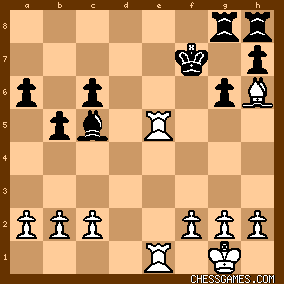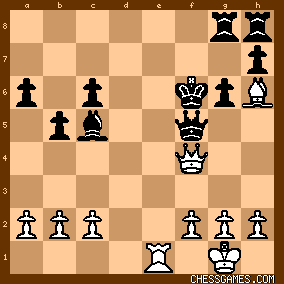|
< Earlier Kibitzing · PAGE 1 OF 2 ·
Later Kibitzing> |
Apr-23-15
 | | Phony Benoni: Definitely Old School. |
|
Apr-23-15
 | | gawain: Didn't get this one. If I'd noticed that the white Q can go to c7 as easily as to e7 then I might have thought about how to deflect the black queen away from that square. Oh well. |
|
| Apr-23-15 | | dfcx: Black has an extra bishop but its two rooks are useless and blocks the king's escape. White could mate with Qe6 if the black bishop were not guarding it. This suggests, 24.Rxd5
A. 24...cxd5 25.Qe5#
B. 24... Qxd5 25.Qc7+ Kf6 (forced) 26.Qf4+ Qf5 27.Bg5+ Kf7 28.Qc7+ Kf8 29.Bh6+ Rg7 30.Qxg7# C. Refusing the rook is not much better
24...Qe7 25.Qf4+ Ke8 (Qf6? Rd7+ mates) 26.Rxe7+ Bxe7 with Q+R+B against B + two useless rooks. |
|
Apr-23-15
 | | Phony Benoni: <dfcx> Amusing, in line B., how the White pieces keep returning to the scene of the crime. |
|
| Apr-23-15 | | Mendrys: A strange puzzle in a way. I had seen up to the game position and knew the position was winning but didn't see 25...Kf6 until after I played thru the game. Still easy to see that the position must be winning for white but it's not so easy to see the mate in 7 afterwards starting with, 26.Qc7-f4+ Qd5-f5 27.Bh6-g5+ Kf6-g7 28.Qf4-c7+ Qf5-f7 29.Qc7-e5+ Kg7-f8 30.Bg5-h6+ Rg8-g7 31.Qe5-b8+ Qf7-e8. So even though I saw 24. Rxd5 I don't give myself full credit as I hadn't calculated all the way to the forced mate. |
|
| Apr-23-15 | | Mendrys: Given that this was a correspondence game it's surprising that Messere didn't see 23...Qb8 instead of the text move. This still leads to lost game after 24. Rxd5 Qxe5 25. Rxe5 but still only a pawn down.

click for larger viewThere may be something better for white instead of the moves above but I don't see anything else. Sacking the rook for the exchange just seems like a very real possibility to explore when analyzing the position. Of course I had the advantage of knowing this was a puzzle position after 23...Qd8 instead. |
|
| Apr-23-15 | | patzer2: For my Thursday puzzle attempt, got as far as the end of the game and the follow-up 25...Kf6 26. Qf4+ Qf5 (diagram below)
click for larger viewHowever, I missed the continuation of the mating attack with 27. Bg5+! Kg7 28. Qc7+ Qf7 29. Qe5+! Kf8 30. Bh6+ Rg7 31. Qb8+ Qe8 32. Qxe8#. The decisive error was <23...Qd8??> Instead, Black should have tried 23...Qb8  (+1.05 @ 25 depth, Deep Fritz 14) with drawing chances. (+1.05 @ 25 depth, Deep Fritz 14) with drawing chances. For level chances for Black, Fritz indicates 13...0-0-0 = (-0.12 @23 depth, deep Fritz 14) improves over <13...Nxb3>. |
|
| Apr-23-15 | | agb2002: White has a pawn for the bishop.
Black threatens 24... Bxf2+ 25.Kxf2 Qf6+ 26.Qxf6+ Kxf6 27.Bd2 Rf8 28.Bc3+ Kg5+ 29.Kg3 Rhg7 with a momentarily unconfortable position. The bishop on d5 stops Qe6#. This suggests 24.Rxd5:
A) 24... Qxd5 25.Qc7+ Kf6 (25... Be7 26.Qxe7#) 26.Qf4+ Qf5 27.Bg5+ A.1) 27... Kf7 28.Qc7+ Kf8 29.Bh6+ Rg7 30.Qxg7#.
A.2) 27... Kg7 28.Qc7+ Qf7 29.Qe5+ (29.Bh6+ Kxh6 30.Qxf7 Rf8 followed by 31... Bxf2+) 29... Kf8 (29... Qf6 30.Qxf6#) 30.Bh6+ Rg7 (30... Qg7 31.Qe8#) 31.Qb8+ Qe8 32.Qxe8#. B) 24... Re8 25.Qg7#.
C) 24... Bxf2+ 25.Kxf2 Qf6+ 26.Qxf6+ Kxf6 27.Rxc5 with a won ending even if Black manages to trap the bishop. |
|
| Apr-23-15 | | bcokugras: 25... Kf6 26 h4 ! |
|
| Apr-23-15 | | stacase: 24.Rxd5 works when you realize Black must follow with 24...Qxd5 not 24...Pxd5 because that leads to 25.Qe6#. But it took me a while. Would I have seen it over the board? Hmmmmm maybe. |
|
| Apr-23-15 | | TheFocus: Too easy. Interesting though. |
|
| Apr-23-15 | | diagonalley: 24.RxB seemed the only candidate move, but the full continuation is difficult to calculate... necessary though, because white at move 24 is already a piece down. hard, even for a thursday. |
|
Apr-23-15
 | | The Long Diagonal: For some reason, when I saw this position I immediately thought: hmm, that looks like a correspondence game. Maybe it was the unusual material imbalance but somehow it just didn't seem quite otb. A rather easy Thursday, though. |
|
Apr-23-15
 | | The Long Diagonal: Except that it was not easy! I was hallucinating and thought that 24.Rxd5 Qxd5 25.Qe7?? is mate. And even after I checked and looked at the final position, I couldn't figure out the win. I did think of 26.Qf4+ Qf5 27.Bg5+ Kf7 but 28.Qc7+ didn't occur to me at all - probably my brain was unable to consider that the queen might go back to the square she just came from. |
|
Apr-23-15
 | | Honza Cervenka: <Mendrys: Given that this was a correspondence game it's surprising that Messere didn't see 23...Qb8 instead of the text move.> Well, it is not so surprising at all. In precomputor age to miss a tactical shot, especially not a trivial one, was no rarity. On the other hand I would like to know why white dismissed obvious and crushing 21.Bxc5 Qb8 22.Qg5 Qd8 23.Qf4+ Qf6 24.Qc7+  . . |
|
| Apr-23-15 | | JimNorCal: agb's line C with Bf2+ muddied the waters sufficiently that I couldn't feel confidence in the outcome. |
|
| Apr-23-15 | | mistreaver: Thursday. White to play. Medium. 24.?
White is a piece down so he has to give mate soon, before black unravels his rooks.
First i wanted to do
24 Bg5 and give mate on f6 after queen moves.
And now looking at it i don't see what black can do:
24 ... Bxf2+
25 Kxf2 Qb6+
26 Kf1
Or
24 ... Re8
25 Qf4+ Kg8
26 Bxd8 Rxd8
are both winning for white.
Time to check and see.
----------------
Wow i am blind, i missed
24... Qd6.
I considered 24 Rxd5 since this is exchange sacrifice week, but didn't see the continuation after Qxd5.
So bad. |
|
| Apr-23-15 | | morfishine: White has a potential seal-off of the Black King with his rooks on the cental files and his DSB on <h6> controlling <g7> <24.Rxd5> removes the defender of <e6>; Black has two replies (1) <24...cxd5>??? 25.Qe6# (2) 24...Qxd5 25.Qc7+ Kf6 26.Qf4+ Qf5 and this is where I got stuck; like
<patzer2> I was unable to find 27.Bg5+ I forgot to count the pieces and only noticed at the end that White was a piece down. Sloppy work for me today :( ***** |
|
| Apr-23-15 | | CHESSTTCAMPS: White is down a pawn for a bishop, but the black king is badly exposed, the white pieces are well-organized, and the defensively placed black rooks have little scope and are actually in the way. White is playing for mate, but not just anything will work, e.g 24.Bg5? is well-defended by Qd6! Instead, white has to do a little maneuvering to set up Qf4+ with maximum effect. 24.Rxd5!!
is the ticket, a candidate that has to be considered because it is forcing, eliminates a light-squared defender, and diverts the black queen from dark-square defense. 24... Qxd5 (cxd5 25.Qe6#) 25.Qc7+! (the finesse behind the combination ) Kf6 26.Qf4+ Qf5 27.Bg5+! Kg7 28.Qc7+ Qf7 (Kf8 Bh6+ forces mate) 29.Qe5+ Kf8 (Qf6 30.Qxf6#) 30.Bh6+ Rg7 (Qg7 31.Qe8#) 31.Qb8+ Qe8 32.Qxe8# Time for review... |
|
| Apr-23-15 | | eblunt: I got up to 26 Qf4+ but missed the continuation 27 Bg5+. I like the way the Queen shuttle from c7 to f4 and back serves to get the Bishop from h6 to g5 with tempo, so that f6 escape is blocked off. Very subtle. |
|
Apr-23-15
 | | Penguincw: I got 24.Rxd5 Rxd5 and even the reason behind it (to remove the defender of e6), but didn't see 25.Qc7+ (I actually saw 25.Qe7+??). |
|
| Apr-23-15 | | TheaN: Thursday 23 April 2015 <24.?> White has sacced his light squared bishop to obtain open files and an exposed enemy king. In addition black's h8-rook is completely boxed in, so effectively white is playing an exchange up. Let that be exactly what white is going to sacrifice even more to win this game. <24.Rxd5!> the bishop on d5 was protecting e6. By taking out the piece of black white is missing, he gains control over the light squares. <24....Qxd5 (cxd5 25.Qe6#)> anything else fails pretty badly. <25.Qc7+!> white has to repostion the black king before taking the f-file. <25....Kf6 (Be7 26.Qxe7#; Qd7 26.Qxd7+ Kf6 27.Qe6#) 26.Qf4+ Qf5 27.Bg5+!> the point of Qc7-f4+. A) <27....Kf7?> puts the black queen out of play <28.Qc7+ Kf8 (Be7 29.Qxe7#; Qd7 29.Qxd7+ Kf8 30.Re8#) 29.Bh6+ Rg7 30.Qxg7# 1-0>. B) <27....Kg7 28.Qc7+ Qf7> other interposings and 28....Kf8 29.Bh6+ are similar to A. <29.Bf6+!!> the point of the position; white retains his dark squared bishop and will win black's queen and later the h8-rook. B1) <29....Kxf6 30.Qe5# 1-0> B2) <29....Kf8 30.Qd8+ Qe8 31.Qxe8# 1-0> B3) <29....Kh6 30.Qxf7  > black can't do much against Bxh8, if he attempts <30....Rf8 31.Qg7+ Kh5 32.Re5+ Kg4 (g5 33.Qxg5#) 33.h3+ Kf4 34.Qh6+ g5 35.Qxg5# 1-0> black is mated straight away. > black can't do much against Bxh8, if he attempts <30....Rf8 31.Qg7+ Kh5 32.Re5+ Kg4 (g5 33.Qxg5#) 33.h3+ Kf4 34.Qh6+ g5 35.Qxg5# 1-0> black is mated straight away. |
|
| Apr-23-15 | | TheaN: Kind of surprised I missed 29.Qe5+: I went for the slightly slower mate and would have probably captured on h8 if black didn't attempt 30....Rf8. Didn't really look at Re4 or a mate. Rest assured, Bf6+ wins in 7 instead of 4. These are the interesting optimilizations in my line B and B3: <28....Qf7 29.Qe5+! #4 vs 29.Bf6+ #7> <30....Rf8 31.Re4! #3 vs 31.Qg7+ #4> <33....Kf4 34.Bg5# vs 34.Qh6+ #2> |
|
| Apr-23-15 | | patzer2: Correction: Instead of <13...Nxb3 14. Nxb3  >, 13...0-0 = gives Black a level game. >, 13...0-0 = gives Black a level game. |
|
| Apr-23-15 | | Longview: I went a different way with this one. I thought that 24. Rxd5 would be answered with cxd5 not noticing that 25. Qe6# was the reply to that. So, I thought about a rook lift, noticing that the d5 Bishop was pinned to the queen, I wanted 24. Re4 thinking Black would be force to swap queen/bishop for 2 rooks but realized that Kf1 was forced and the bishop escapes. White still has advantage but not mate any time soon.
click for larger viewSo much for my mental moving for the day! I still struggle with the second and third moves on the candidate paths. |
|
 |
|
< Earlier Kibitzing · PAGE 1 OF 2 ·
Later Kibitzing> |





